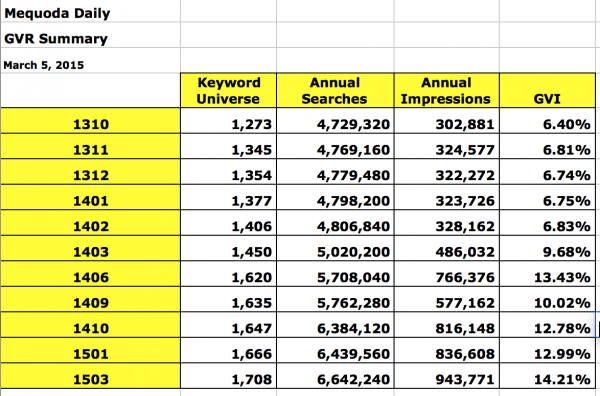Knowing your Google Visibility – how much qualified website traffic Google should be sending you – is just a matter of doing the numbers
Almost a decade ago, a colleague told me that it was impossible to figure out how much search traffic a website could or should be receiving from Google and other search engines. They were wrong. I hope these days they know this, and also how to find their top keywords and their top trafficked blockbuster posts, because those are important too.
Let me explain how to calculate the amount of traffic Google and other search engines could be sending your way.
[text_ad]
Google visibility revealed
Google keeps track of every search made by every human being and software program on the World Wide Web. Much of that data is accessible for those who know how to use the Google Keyword Planner. It takes an experienced analyst 60 to 100 hours to build a comprehensive keyword universe for a content-driven website. The process begins by reviewing the content that will be deployed on the website. The analyst then works with the site’s chief content officer or editor-in-chief to discover the best way to organize that content into a three level hierarchy that can include uber keyword phrases, primary keyword phrases, and secondary keyword phrases or tags.
The initial primary keyword phrases are then entered into the Google Keyword Planner one at a time to quantify annual searches for that term and discover what could be hundreds of related keyword phrases. This process is repeated for each primary phrase, and the results are examined for alternate or additional primary phrases that Google may suggest. All the research is then organized and detailed to create a keyword universe for the website that matches its content production schedule.
For our website, the keyword universe currently represents 6,642,240 searches per year. In March of this year, we had a 14.21% Google Visibility Index, which means that we show up in the first few pages of Google for 14.21% of the keywords in our Keyword Universe, which consists of 1,708 keywords we’re currently targeting in posts, or plan to target.

The long tail factor
The Google Keyword Planner does not reveal every keyword phrase that is related to your primary. In fact, the tool will only reveal phrases that have been searched for 120 times during the trailing 12 months. Google does not reveal what author Chris Anderson calls the long tail.
Our research has revealed that the long tail for organic search is very close to a standard long tail distribution. The keyword phrases Google reveals represent about 20 percent of total search volume in the US for a given cluster of keyword phrases. This means that 80 percent of the search traffic which will arrive at your website will do so using long tail keyword phrases that are used less than 120 times per year or 10 times per month. Thus, to discover your entire search universe size, you must multiply your known keyword universe by five, a number we call the long tail factor.
[text_ad]
Organic search engine visibility
There are many programs on the market to monitor search engine ranking, we use Advanced Web Ranking to create a Google Visibility Report. This tool looks up your website position for each of the keyword phrases in your known keyword universe. From there, we apply a visibility percentage for each position from 1 to 30. Nobody searches past page three in 2015 except someone looking for him or herself. If we assume 100 percent of searchers see a listing on page one, and five percent see a listing on page two, and one percent see a listing on page three, we can combine the above data to estimate the number of organic search engine impressions our website is receiving during any given period.
Organic search arrivals
This is the easy part. Simply go to your Google Analytics report and set the date range to include search arrivals for the last 12 months. You can further calculate the implied click through from Google listing to website arrival by dividing the arrivals by the impressions.
Predicting your Google Visibility Index (GVI)
With a keyword universe in hand, you can calculate the Google Visibility Index for any website including your own. We have successful clients, and by successful I mean profitable, who have Google Visibility Indexes that range from one percent to 65 percent. Most of our clients have a visibility index of between five percent and 10 percent. Having a high visibility index is controlled by a number of factors including competition, 3C zone architecture, and website content. Other factors like inbound links and social media participation (like our 12x12x12 social promotion strategy) also impact the position your website can hold on each individual keyword phrase in your keyword universe, and thus your composite Google Visibility Index.
This data comes in handy for a number of uses. First and foremost, we can use it to size the revenue potential for any online business. Next, we can use it to guide the architecture of our website. And finally, we can use it to guide the day-to-day content development efforts of every content producer on our team.
Astonishingly, a Google Visibility Index of just more than one percent can drive more than 200,000 qualified high-value B2B customers to a website. We’ve seen it happen. The power of visibility is an awesome thing.
If you have questions or thoughts about the process I described above, please feel free to post them below!



Hi Kim–about a decade ago someone big in SEO told me the same thing–that you can’t set up metrics for this kind of thing. The thing is, you can set up tracking and analysis for just about anything. Thanks for the post.
I love it that there is a reliable way to design for relevance and track the traffic results. Thanks, that was inspiring.